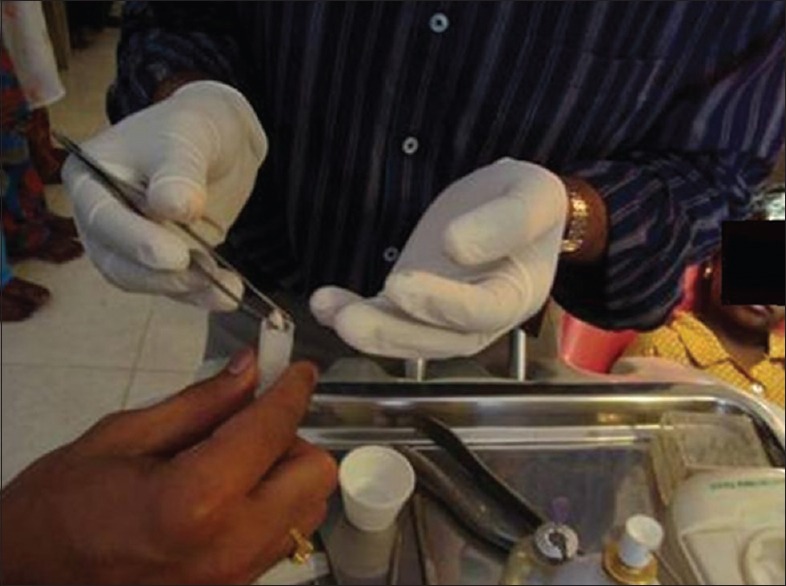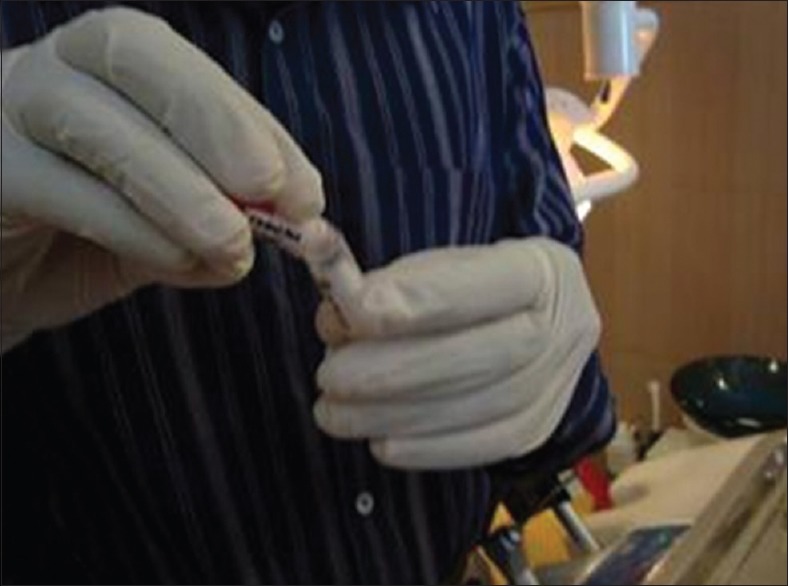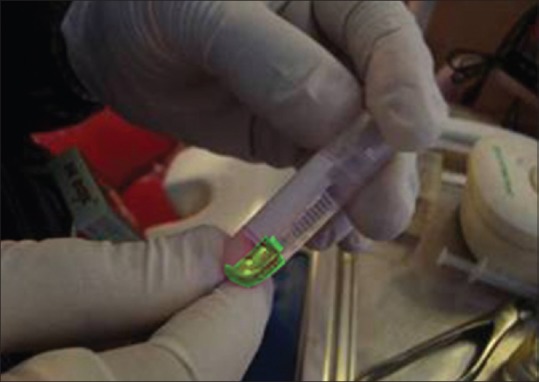Abstract
Dental stem cells have recently become one of the widely researched areas in dentistry. Ever since the identification of stem cells from various dental tissues like deciduous teeth, dental papilla, periodontal ligament and third molars, storing them for future use for various clinical applications was being explored. Dental stem cells were harvested and isolated using various techniques by different investigators and laboratories. This article explains the technical aspects of preparing the patient, atraumatic and aseptic removal of the tooth and its safe transportation and preservation for future expansion.
KEY WORDS: Dental stem cell banking, dental stem cells, dental pulp
Cells which have a remarkable capacity for self-renewal and potency and can give rise to different types of cells and tissues are called stem cells.[1] Stem cells can be isolated from various tissues from the human body which can be hematopoietic or mesenchymal origin. Stem cells isolation from bone marrow and other tissues were done with team comprising anesthetists and surgeons. In previous decades, isolation and harvesting stem cells were not within reach for dental surgeons, but after the invention of dental stem cells, the dental surgeons have a vital role in the field of stem cell isolation and harvesting. Dental stem cells can be isolated from pulp, which harbors neural crest differentiated stem cells.[2] Dental pulp is easily accessible tissue which has less morbidity after harvesting.[3] They can be harvested from both deciduous teeth (stem cells from human exfoliated deciduous teeth [SHED][4]) and adult teeth (teeth removed for orthodontic purposes, impacted teeth, and supernumerary teeth). The remarkable advantages of dental stem cells are, nonimmunogenic, good match for the entire family, risk of communicable diseases can be avoided, easy accessibility, and remedy for organ shortage which is an expected future necessity. This article briefly summarizes the technique of harvesting dental stem cells and their applications.
Sample Selection Criteria for Dental Stem Cells
Tooth selection for dental stem cell banking (DSCB) should satisfy the requirements given below.
Deciduous teeth
Pulp should appear red in color indicating blood supply
Deciduous teeth with two third of root are preferred
Posterior deciduous teeth are not preferred because of less pulp and chance of infection due to longer retention in the mouth than anterior
Extracted teeth are preferred than exfoliated teeth.
Adult teeth
Only vital teeth should be harvested
Teeth with infection and any pathology is not preferred
Periodontally compromised teeth cannot be harvested
Teeth should have a sufficient amount of pulp.
Harvesting and Isolation
Dental surgeon should first examine the tooth and rule out any infection in the scheduled area and extraction of the tooth should be carried out in a sterile environment after getting consent of the patient (consent of parents should be taken in case of minors).
Guidelines for extraction of tooth for harvesting
Procedure should be done under sterile environment
Prophylactic antibiotic usage 1h before and antiseptic mouthwash just before the extraction
Draping and Betadine prepping around the skin to be done
Extraction should be carried out carefully avoiding breaking the crown
Care should be taken to avoid contamination of extracted teeth and immediately transfer into the container.
Postextraction protocol
Gently wash the tooth in 70% ethanol by dipping inside the tube I [Figure 1]
Rinse the tooth in phosphate buffered saline containing antibiotics (100 IU/ml penicillin and 100 μg/ml streptomycin) by dipping it five to seven times (depending upon size of teeth) in tube II to remove ethanol
Transfer the tooth to tube III [Figure 2] for further processing
Add 2 ml of tooth preservation cocktail (TPC) (depend upon the company you are sending for preservation) over the tooth in tube III [Figure 3]
Leave it for 5 min
Add 1 ml of nourishment medium over the TPC in tube III
Seal the tube with paraffin film after proper labeling
Transport the tube III to the cell processing laboratory before 48 h under room temperature.
Figure 1.

After rinsing with phosphate buffered saline and alcohol the sample is transferred to tube III
Figure 2.

Adding 2 ml of tooth preservation cocktail
Figure 3.

Sample embedded in tooth preservation cocktail and nourishment media
The process of retrieval of the pulp can be done either in the dental clinic or more preferably in laboratory meant for preservation. In the cell processing center, the pulp is retrieved either by using sterile barbed broach or by cutting the tooth using diamond disc along with coolant to avoid damage to the pulp. The isolated pulp is then trypsinized and cultured to yield colonies of stem cells. The cells are then sorted using fluorescence activated cell sorting system and passed through appropriate stem cell markers, and stored in the facility by either cryopreservation or magnetic freezing depending upon the technique available in the laboratory.
Discussion
Earlier documented studies have shown that dental stem cells have multiple lineages which can be maneuvered into cells like osteoblasts, adipoblasts, etc., in vitro using appropriate laboratory conditions. Role of dental stem cell is untenable in future, and dental surgeons can play a major role in it. Experimental studies on animals have proved dental stem cells especially SHED have multiple lineages. Experimental studies have shown that it can differentiate into active neurons which prove its usefulness in the management of degenerative disorders such as Alzheimers and Parkinsonism.[5] It is also shown in experimental studies that dental stem cells can regenerate an infracted area in the experimental rats after induced myocardial infarction with angiogenesis and improved ventricular function.[6]
Dental stem cells can differentiate into osteoblasts which can be a good source for bone regrowth in osseous defects.[7] Apart from adipogenic and chondrogenic lineages, dental pulp cells were able to form islet-like aggregates which may be a great boon for type 1 diabetes patients.[8] Dental stem cells can be used to regenerate tooth which was experimentally proved in animal models using dental stem cells.[9]
Banking dental stem cells might invite many clinical applications in future. It is a recent concept gaining momentum among professionals and patients. Cord stem cell banking is prevalent all over the world through various commercial establishments. DSCB is slowly getting popularized because of its advantages over cord stem cell banking. It can be harvested in later part life even if parents missed the chance of storing umbilical cord, it can be stored at various stages starting from deciduous teeth to the last tooth erupted, cost effective for banking comparing to cord stem cell banking and has got multiple lineages.
Dental stem cells beyond denial will attract adulation from every respect of professional in future. Currently, various researches were done on dental stem cells in respect to their isolation, expansion, and application globally and in India, it is slowly picking up. Dental stem cells have some limitations like limited availability of stem cells (because of volume of tissue) and not many human studies were done on its clinical application, it will be definitely a useful tool in regeneration of different body tissues in future.
Financial support and sponsorship
Nil.
Conflicts of interest
There are no conflicts of interest.
References
- 1.Fortier LA. Stem cells: Classifications, controversies, and clinical applications. Vet Surg. 2005;34:415–23. doi: 10.1111/j.1532-950X.2005.00063.x. [DOI] [PubMed] [Google Scholar]
- 2.d’Aquino R, De Rosa A, Lanza V, Tirino V, Laino L, Graziano A, et al. Human mandible bone defect repair by the grafting of dental pulp stem/progenitor cells and collagen sponge biocomplexes. Eur Cell Mater. 2009;18:75–83. doi: 10.22203/ecm.v018a07. [DOI] [PubMed] [Google Scholar]
- 3.Jo YY, Lee HJ, Kook SY, Choung HW, Park JY, Chung JH, et al. Isolation and characterization of postnatal stem cells from human dental tissues. Tissue Eng. 2007;13:767–73. doi: 10.1089/ten.2006.0192. [DOI] [PubMed] [Google Scholar]
- 4.Miura M, Gronthos S, Zhao M, Lu B, Fisher LW, Robey PG, et al. SHED: Stem cells from human exfoliated deciduous teeth. Proc Natl Acad Sci U S A. 2003;100:5807–12. doi: 10.1073/pnas.0937635100. [DOI] [PMC free article] [PubMed] [Google Scholar]
- 5.Arthur A, Rychkov G, Shi S, Koblar SA, Gronthos S. Adult human dental pulp stem cells differentiate toward functionally active neurons under appropriate environmental cues. Stem Cells. 2008;26:1787–95. doi: 10.1634/stemcells.2007-0979. [DOI] [PubMed] [Google Scholar]
- 6.Gandia C, Armiñan A, García-Verdugo JM, Lledó E, Ruiz A, Miñana MD, et al. Human dental pulp stem cells improve left ventricular function, induce angiogenesis, and reduce infarct size in rats with acute myocardial infarction. Stem Cells. 2008;26:638–45. doi: 10.1634/stemcells.2007-0484. [DOI] [PubMed] [Google Scholar]
- 7.Carinci F, Papaccio G, Laino G, Palmieri A, Brunelli G, D’Aquino R, et al. Comparison between genetic portraits of osteoblasts derived from primary cultures and osteoblasts obtained from human pulpar stem cells. J Craniofac Surg. 2008;19:616–25. doi: 10.1097/SCS.0b013e31816aabc8. [DOI] [PubMed] [Google Scholar]
- 8.Govindasamy V, Ronald VS, Abdullah AN, Nathan KR, Ab Aziz ZA, Abdullah M, et al. Differentiation of dental pulp stem cells into islet-like aggregates. J Dent Res. 2011;90:646–52. doi: 10.1177/0022034510396879. [DOI] [PubMed] [Google Scholar]
- 9.Nakahara T, Ide Y. Tooth regeneration: Implications for the use of bioengineered organs in first-wave organ replacement. Hum Cell. 2007;20:63–70. doi: 10.1111/j.1749-0774.2007.00031.x. [DOI] [PubMed] [Google Scholar]


